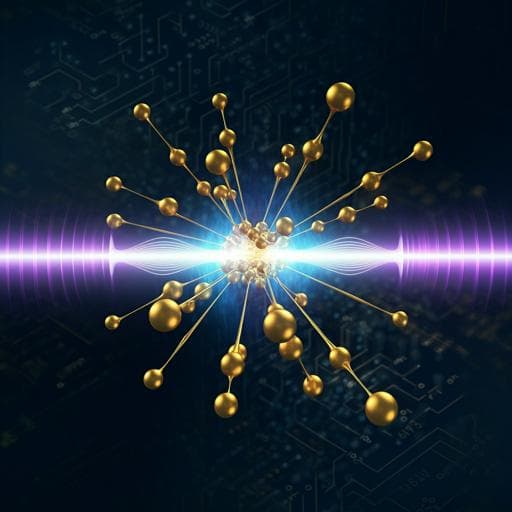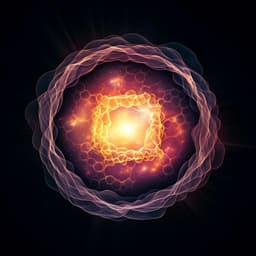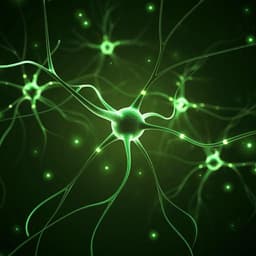
Physics
Real-time tracking of coherent oscillations of electrons in a nanodevice by photo-assisted tunnelling
Y. Luo, F. Neubrech, et al.
This research showcases groundbreaking real-time tracking of electron oscillations in a unique Au bowtie nanoantenna, revealing a fascinating T2 decay time of ~8 femtoseconds. Conducted by Yang Luo, Frank Neubrech, Alberto Martin-Jimenez, Na Liu, Klaus Kern, and Manish Garg, this study highlights the potential for on-chip light-wave electronics in quantum nanodevices.
~3 min • Beginner • English
Introduction
The study investigates how to directly resolve coherent collective electron oscillations (localized surface plasmons) in metallic nanostructures in the time domain. Interaction of light with metallic nanostructures can strongly enhance electromagnetic fields and induce nonlinear electronic motion with frequency components at multiples of the driving frequency. While prior work has largely characterized plasmonic responses spectrally (e.g., absorption, transient reflectivity, second/third harmonic generation) or via ultrafast techniques such as TR-2PPE and TR-SNOM, these approaches do not capture the phase of frequency-dependent plasmon oscillations and have not directly sampled local near-fields in real time. The research question addressed is whether one can directly track, in real time and with phase sensitivity, the coherent plasmonic and nonlinear electron oscillations in a nanoscale device, and disentangle their linear and nonlinear contributions. The authors propose using photo-assisted tunnelling currents in Au bowtie nanoantenna junctions driven by few-cycle laser pulses and a homodyne beating scheme to realize sub-cycle time-domain sampling of local fields and their phase.
Literature Review
The paper situates its work within prior studies of plasmon-enhanced fields and nonlinear responses in nanostructures, commonly accessed via UV–IR spectral techniques (absorption spectroscopy, transient reflectivity) and nonlinear spectroscopy (second and third harmonic generation). Ultrafast nano-imaging and spectroscopy (TR-2PPE, TR-SNOM) have mapped plasmon dynamics with high spatial resolution but typically lack direct phase retrieval of frequency-dependent plasmon oscillations and do not provide direct time-domain sampling of local near-fields. Recent experiments demonstrated CEP-controlled photo-assisted tunnelling currents in plasmonic devices, indicating sensitivity to optical phase, yet direct time-domain sampling of coherent collective electron oscillations and local fields had not been reported. The present work addresses this gap by implementing a self-referenced homodyne beating method to retrieve amplitude and phase of plasmonic and higher-order nonlinear electron oscillations in real time.
Methodology
- Nanodevice: Arrays of seven identically designed Au bowtie nanoantennas (~300 nm isosceles triangles) on fused silica, with designed junction gaps of a few nanometers (nominal designs included 10 nm, 5 nm, 0 nm, and negative gaps for merged triangles). Electrical connections fan out to address each array; two arrays replaced by a rectangle for reference. Actual fabricated gaps can deviate due to resist exposure and proximity effects; SEM indicates single-bowtie gaps as small as ~8 nm, with smaller unresolvable gaps possible.
- Excitation: Carrier-envelope phase-stable ultrashort laser pulses, pulse duration ~7 fs, central wavelength ~800 nm, repetition rate fr ~80 MHz, are split in a Mach–Zehnder interferometer. One arm passes through an acousto-optic frequency shifter (AOFS) driven at fR + f0 (~80 MHz + ~700 Hz) to generate a first-order diffracted beam (pulse-1) with a slight carrier frequency upshift f0 relative to the original beam (pulse-2). The two pulses are recombined with controllable delay τ and focused onto the nanoantenna junctions with an off-axis parabolic mirror (f = −2.5 cm).
- Pulse control and characterization: Temporal dispersion from the AOFS is precompensated with double-angled chirped mirrors; a matched fused silica block (~20 mm) inserted in the other arm ensures identical pulse profiles. Pulses are characterized by non-collinear SHG FROG to be transform-limited (~7 fs). CEP of pulse-1 is tunable via a phase shifter driving the AOFS, enabling CEP modulation experiments while keeping pulse-2 CEP fixed.
- Detection: A bias voltage (up to ~3 V) is applied across the nanoantenna junction to facilitate electron tunnelling. Photo-assisted tunnelling current induced by the local plasmonic field is amplified (Femto DLPCA-200, 10^6 V/A) and measured by lock-in detection at the offset frequency f0 and its harmonics (2f0, 3f0). Intensity modulation at ~520 Hz is used for total photocurrent scaling measurements.
- Homodyne beating principle: The local near-field is the convolution of the incident field and the antenna response, EL(t) ∝ Ei(t) * R(t) for i = 1,2. Two pulses with carrier frequencies differing by f0 generate an interference (beating) term at f0 in the photo-assisted tunnelling current proportional to E(t)^2, isolating amplitude and phase of the local field. Lock-in detection at f0 samples linear plasmon oscillations; detection at 2f0 and 3f0 samples second- and third-order nonlinear electron oscillations.
- Modelling and simulations: Finite element simulations compute the plasmonic resonance and near-field enhancement in the bowtie junctions (e.g., second-order resonance near 770 nm for a 10 nm gap, field polarized along long axis). Plasmon dynamics are modelled as a driven damped harmonic oscillator with response Epl(t) ∝ ∫ ELaser(t') exp(−γ(t−t')) sin(ωp(t−t')) dt', with ωp ~1.6 eV and damping γ ~0.12 fs−1, corresponding to a linewidth ~160 meV. Fourier analysis provides spectrum and spectral phase for comparison with experiment.
- Power and bias dependence: Photocurrent vs incident field strength is recorded at zero delay with lock-in at f0 and 2f0 to disentangle linear and second-order contributions. Photocurrent vs bias at fixed pulse energy (~100 pJ) probes the tunnelling mechanism; calculations based on photo-assisted tunnelling across effective gaps (e.g., ~1.2 nm) are compared to experimental nonlinearity. Keldysh parameter estimates (>4) exclude strong-field, laser-driven direct tunnelling.
- Operating conditions: Measurements performed under ambient conditions. Pulse energies for nonlinear sampling: ~100–200 pJ (second-order), up to ~300 pJ (third-order, less stable due to possible electromigration/field evaporation risk).
Key Findings
- Real-time sampling of plasmon oscillations: The device enables direct time-domain tracking of plasmon-driven local fields via homodyne beating detected in photo-assisted tunnelling current. The observed oscillation period is ~2.6 fs. The plasmonic response exhibits a strongly damped, delayed tail on positive delays.
- Damping and dephasing: The plasmon oscillations have a noninstantaneous response with T2 decay time ~8 fs. A driven damped harmonic oscillator model with ωp ~1.6 eV and γ ~0.12 fs−1 (linewidth ~160 meV) reproduces the measured field and spectrum, including a ~3 fs delay of the plasmonic field peak relative to the driving pulse.
- Spectral phase: The plasmon spectral phase is highly dispersive, exhibiting an approximately π-radian phase shift across the resonance, consistent with resonant driven oscillator behavior. The plasmonic spectrum differs markedly from the incident pulse spectrum due to antenna response and near-field enhancement.
- Nonlinear electron oscillations: Lock-in detection at 2f0 and 3f0 directly samples second- and third-order nonlinear electron oscillations with oscillation periods ~1.3 fs (2nd order) and ~0.9 fs (3rd order), revealing significant spectral shaping from multi-photon interactions.
- Power scaling and channel disentanglement: Total photocurrent vs intensity switches from linear scaling (slope ~1) at low fields to quadratic (slope ~2) at higher fields. Lock-in f0 signal contains both linear and nonlinear contributions (prefactor 0.5), whereas 2f0 isolates second-order polarization (prefactor 1/8) and scales purely quadratically. The onset of the 2f0 signal coincides with the transition in total photocurrent scaling, enabling quantitative separation of linear and nonlinear channels. The 3f0 signal is too weak for reproducible quantification under damage-safe conditions.
- Tunnelling mechanism: Photocurrent vs bias shows strong nonlinearity, inconsistent with over-the-barrier photoemission or laser-field-driven direct tunnelling at the applied biases. Photo-assisted tunnelling, where electrons excited up to ~1.6 eV above EF traverse a reduced effective barrier, explains the data. Calculations for an effective junction gap ~1.2 nm reproduce the measured bias dependence; such a gap is too large for DC tunnelling below ~5 V but compatible with photo-assisted tunnelling.
- Phase control: By varying the carrier-envelope phase of one pulse (via AOFS phase shifter) while keeping the other fixed, the temporal phase of plasmon oscillations is coherently controlled, evidenced by linear shifts of oscillation maxima in the time-domain traces.
- Operating parameters: CEP-stable ~7 fs pulses at ~800 nm, fr ~80 MHz, f0 ~700 Hz; typical pulse energies ~100–200 pJ (stable), with third-order sampling demonstrated up to ~300 pJ albeit with stability concerns due to potential electromigration/field evaporation.
Discussion
The results directly address the central goal of time-domain, phase-resolved measurement of coherent plasmonic and nonlinear electron oscillations in a nanoscale device. By leveraging homodyne beating of two few-cycle pulses with a slight carrier frequency offset and detecting photo-assisted tunnelling currents at f0 and its harmonics, the method retrieves both amplitude and phase of local near-fields and disentangles linear and higher-order polarization pathways in real time. The measured delayed response, dephasing time (~8 fs), and dispersive spectral phase validate a driven damped harmonic oscillator picture of localized plasmons near resonance and confirm significant temporal reshaping by the antenna response. The channel-resolved power scaling demonstrates clear transitions from linear to quadratic regimes and enables quantitative assignment of contributions to the tunnelling current, while bias dependence confirms photo-assisted tunnelling as the operative mechanism under ambient, moderate-bias conditions. Coherent phase control via CEP directly modulates the temporal phase of plasmon oscillations, illustrating external control over ultrafast electron dynamics. Collectively, these capabilities provide a pathway toward petahertz-bandwidth on-chip light-wave electronics, phase-sensitive diagnostics of near-fields, and time-domain studies of strong light–matter interactions at the nanoscale.
Conclusion
The study demonstrates a self-referenced, time-domain approach to measure and control coherent plasmonic and nonlinear electron oscillations in Au bowtie nanoantenna junctions via photo-assisted tunnelling. Using ~7 fs CEP-stable pulses and homodyne beating with a small frequency offset, the authors retrieve amplitude and phase of local near-fields, quantify a T2 dephasing time ~8 fs and a ~3 fs delay relative to the driving field, and disentangle linear and higher-order (second-, third-order) contributions to the tunnelling current. Phase control of plasmon oscillations is achieved by CEP modulation. Operating under ambient conditions, the method opens prospects for on-chip light-wave electronics at petahertz frequencies, ultrafast switching, and field-resolved probing of nanoscale systems. Future directions include extending the technique to single-molecule polarization dynamics in the junction, sampling higher-order channels with improved device robustness, and leveraging the inversion of the oscillator model to retrieve driving fields and explore quantum optical properties of ultrashort pulses at the nanoscale.
Limitations
- Stability at high pulse energies: Measurements at ~300 pJ needed for third-order sampling are unstable due to risk of electromigration or field evaporation, limiting reproducible 3f0 detection.
- Weak higher-order signals: The 3f0 photocurrent contribution is too weak to be reproducibly quantified under damage-safe conditions.
- Junction gap uncertainty: Actual junction gaps deviate from design and SEM resolution limits may miss sub-8 nm features; modelling of bias dependence uses an effective gap (~1.2 nm), introducing uncertainty.
- Device variability: Within an array, junction sizes can vary due to resist exposure and proximity effects, potentially affecting uniformity of response.
- Mechanistic modelling simplifications: For certain comparisons (e.g., bias dependence), calculations consider only single-photon excitation channels; more comprehensive models including multi-photon pathways and detailed barrier profiles could refine quantitative agreement.
Related Publications
Explore these studies to deepen your understanding of the subject.







